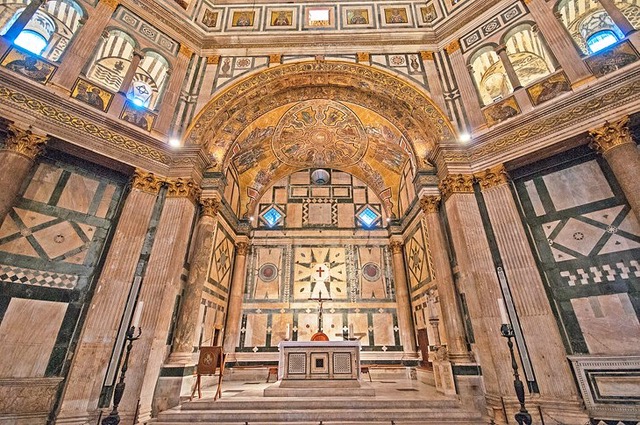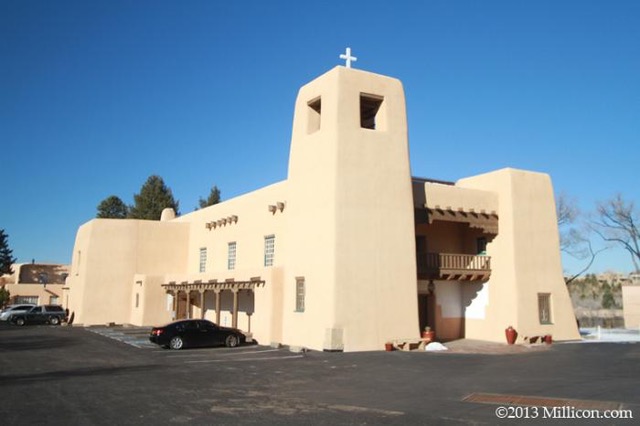The impetus for the following was a concert of Medieval Christmas Music by the Boston Camarata at Cristo Rey Catholic Church on Canyon Road in Santa Fe. Unfamiliar songs, performed by a group we had never heard or even heard of, in a venue we knew of but had not been in. Both the ensemble and their selections were outstanding. The site – the largest adobe building in the United States and home of the “Reredos of Our Lady of Light” altar screen – even more so. We are not what you would call pious people. But we are very much drawn to art and architecture that depicts subjects, themes, and imagery from religion.
It began in 1997 during a vacation in Malta. We chose to go there simply because Marsha saw a magazine article about "Vacations Off The Beaten Path" one day at our hairstylist – and that was one of the places. The story showed a photo of the walled city of Valletta and she immediately said "we have to go there." Jim looked at the same picture and instantly agreed. It probably was the light. We both are drawn to almost blindingly-bright-with-natural-light locations – high desert in New Mexico, arid wasteland in the Big Bend of Texas, sand bunkers on golf courses. (Marsha not so much the latter.) Five years earlier, with images of sun-blanched desert skulls from a recently seen Georgia O'Keeffe exhibit fresh in our own skulls, it took us about the same amount of time to decide on our first trip to New Mexico.
Our travel agent D arranged the vacation with a perfect mix of planned day trips, on-our-own-to-explore time and tour-company support. 👏
Although it was the brightness that brought us there we were attracted to one of Malta’s main houses of worship by the darkness – specifically the chiaroscuro contrasts between light and dark in the paintings of Caravaggio – “the most famous name who worked in Malta.” (St. Paul not withstanding.) Caravaggio was there in 1608 while on the lam from a shady past in sunny Italy where, perhaps unintentionally, he had killed a man. He left behind two masterpieces, “Beheading of St John the Baptist” and “St. Jerome Writing” – both on display at the Co-Cathedral of St. John.
Once inside we were totally awed by the expansive ornate interior with its intricately carved limestone walls, painted vaulted ceiling, elaborate side altars and self-proclaimed "most beautiful floor in the world.” More ecclesiastical space than we had ever been in, and seemingly none of it blank. Sure, we had seen similar images in magazines and on TV. But never before the real thing. “Toto, I've a feeling we're not in Connecticut anymore.”
The experience whet our appetite for more. There are (believe it or not) 359 churches and chapels on the 122 sq. mi. archipelago. We visited a few more, but not enough. So in 2002, ten years after our first trip to New Mexico, we ventured to Barcelona, Spain on an Elderhostel (now Road Scholar) program to learn more about the works of Antonio Gaudi whose Catalan Modernist architecture features organic shapes inspired by natural forms. At the top of our list was La Sagrada Famiglia Church, his possibly never-to-be-finished attempt to transubstantiate the configurations of the physical world into a manmade metaphysical monument to his God. The construction began in March 1882 and is still incomplete. Gaudi himself projected it would take 200 years. An interesting estimate since, as was his wont, he never made a complete blueprint, preferring to add the details as he saw the structure coming to life. Gaudi died in 1926 and other architects are continuing the work.
The texture and shape of La Sagrada has been described as looking like melting wax or sculpted sand. And evoked in us the same feelings of awe and peace that we feel in parts of New Mexico’s landscape – towering shapes that somehow manage to be both harshly unsettling and at the same time comforting in their soft lines and colorless color.
In addition to bringing to mind the terrain of our new home state Gaudi’s organic design philosophy also exemplified the Official State Motto of New Mexico, “Crescit Eundo” (“It Grows As It Goes”.) The expression is from a 1st century poem by Lucretius, where it describes a thunderbolt streaking across the sky, growing bolder and mightier the longer its magnificent journey continues.
Still not enough sacredness for us. So, four years later we listened as another Elderhostel Art Historian told us, “ninety percent of all the great art in the world is in Italy. And eighty-nine percent of that is in Florence,”.
The city’s churches and museums can be overwhelming in both their vastness and the sheer volume of masterpiece-level works of fine art within them. The religious buildings more so because all the artwork is done “in situ” – sometimes in seemingly impossible places. Like Malta every apparent inch of available space was used. Here, some artists’ works also hung in the city’s museums.
For various unrelated reasons our survey of the sacred art of Europe ended after our Florentine adventure. Which was okay because, while all of the above was happening we discovered something completely different in the churches of northern New Mexico.
Beginning in the late 16th century the Spanish came here with the intent of bringing their culture – and most importantly their Catholic religion – to this unfamiliar New World territory. But there were two major obstacles. There were never enough priests. And, while the artists and crafts people were here, the raw materials needed to create the familiar sacred art and architecture just did not exist locally. As a result…
“There are few iconic structures more fundamental to the culture and history of the Southwest than its adobe churches,” wrote John Benigno whose project “to photograph as many adobe churches as possible while they were still in their traditional state” can be seen at https://luminous-landscape.com/adobe-churches-new-mexico-built-earth-faith.
The architects of these edifices were the European Franciscan priests and brothers who planned to replicate the dressed-stone "fortress-churches" that their fellow clergy had erected in Mexico during their conquest of that colony. However, “carried to New Mexico, to a semiarid frontier environment where inconstant adobe, field stone, and wood replaced reliable masonry, such ideals were [quickly forgotten.] Local materials, relatively few and unskilled workmen, poverty, and isolation all contributed to a unique and, as it turned out, an all but invariable New Mexican style.” (npshistory.org)
Still, while not what they had hoped for, adobe did satisfy “the invaders' insistence on erecting churches of churchly proportions.” Interiors would be 25’ x 80’ or more. Height never exceeded width. Most churches had windows on only one side. To illuminate the altar they used a “transverse clerestory window” – a wide low overhead opening that spanned the structure. The effect was theatrical – focusing the viewer “immediately on the stream of light descending like the Dove precisely on altar and reredos.”
Decorations were sparse. “Above the main altar, if the painted wall itself did not serve, stood the carved and painted wooden reredos, or retablo, forming a matrix for the patron and companion saints who stared out from timeworn statues or from animal-hide paintings.” There were no pews – with sometimes a bench along the wall, and perhaps a modest side altar.
Instead of gold leaf inlay there were thinly sliced pieces of straw. Tin replaced silver. “Separated from their nearest supply points in Mexico, Spanish colonial-era artists in New Mexico made do with the materials they found here. Cottonwood branches and roots became bultos, or statues. Pigments derived from rocks and insects turned into paint for retablos, the flat paintings of saints. Animal hides served as canvas. Those creative colonists gave birth to an art-form that was unique to the Southwest – and that still thrives today.” (New Mexico Magazine)
This lasted until the 1850 arrival of U.S. Territorial New Mexico’s first Bishop, Jean Baptiste Lamy (from France by way of Cincinnati.) To him these adobe churches “were lowly, obscene, utterly lacking in architectural character, like the stable of Bethlehem.” Not at all “the high architectural art whose tradition he had inherited. [He would be] a civilizer, a bringer of orthodoxy to benighted folk Catholics.”
In Santa Fe Lamy helmed the construction of the French Romanesque Revival Cathedral Basilica of Saint Francis of Assisi (aka St. Francis Cathedral) and Gothic-Revival Loretto Chapel with its “miraculous staircase.” His actions also led ultimately to the 1940 erection of the setting for “one of the most extraordinary pieces of ecclesiastical art in the country” – and prompted this piece of writing.
The 25’ x 18’ stone “Reredos of Our Lady of Light” altar screen at Cristo Rey church was carved in 1761 to be hung in La Castrense military chapel on the Santa Fe Plaza. Lamy removed the reredos and transferred it to La Parroquia, the main parish church of Santa Fe at the time. He then sold the Castrense. When La Parroquia was replaced by the Cathedral the screen was consigned to a small room away from public view at St Francis until 1940, when it was moved to its present adobe church abode.
It was our first time in Cristo Rey. We lived for a short time in its neighborhood during our 2017 summer of house-hunting – but its doors were never open for spontaneous tourism.
Described as the “last great adobe mission,” by architecture critic Chris Wilson the church was designed in the what is now known as the Pueblo Revival style by John Gaw Meem, who revolutionized architecture in the southwest by mixing progressive elements and materials with well-known regional architectural styles.
125’L x 40’W x 33’H, with walls up to nine feet thick the building is made up of around 200,000 individual adobes supported by a hidden steel frame. The Reredos dominates the otherwise barely adorned altar. A window above illuminates the textured form of the stone carving, while also drawing attention to the area upon which the liturgy is focussed. 14 Stations of the Cross with frames of handworked tin line the side walls. And that’s about it. Just the way it should be out here.
Over the years we’ve been able to sample several stops on the spectrum of sacred art – from Old World complexity to New Mexican minimalism. Meanwhile Barcelona’s La Sagrada Famiglia is becoming less like an outgrowth of the earth and more and more of a cathedral – iteratively transcending even our own state’s aspirationally ambitious motto. It grows, as it goes, as it goes, as it goes…
Speaking of which. Theodore Roosevelt once said “Do what you can, with what you've got, where you are.” From what we’ve learned visiting and living here, that would be just perfect as an expression of New Mexico’s beliefs and ideals. It certainly has become our preferred aesthetic viewpoint.







No comments:
Post a Comment